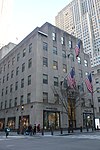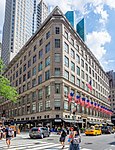Atlas (statue)

Atlas is a bronze statue in Rockefeller Center, within the International Building's courtyard, in Midtown Manhattan in New York City. It is across Fifth Avenue from St. Patrick's Cathedral. The sculpture depicts the ancient Greek Titan Atlas holding the heavens on his shoulders.Atlas was created by the sculptor Lee Lawrie with the help of Rene Paul Chambellan and was installed in 1937. The sculpture is in the Art Deco style of Rockefeller Center. The figure of Atlas in the sculpture is 15 feet (4.6 m) tall, while the entire statue is 45 feet (14 m) tall. It weighs 7 short tons (6,400 kg), and is the largest sculpture at Rockefeller Center.Atlas is depicted carrying the celestial vault on his shoulders. The north-south axis of the armillary sphere on his shoulders points towards the North Star's position relative to New York City. The statue stands on one muscular leg atop a small stone pedestal, whose corner faces Fifth Avenue.
Excerpt from the Wikipedia article Atlas (statue) (License: CC BY-SA 3.0, Authors, Images).Atlas (statue)
Rockefeller Plaza, New York Manhattan
Geographical coordinates (GPS) Address Phone number Website Nearby Places Show on map
Geographical coordinates (GPS)
| Latitude | Longitude |
|---|---|
| N 40.758922222222 ° | E -73.977177777778 ° |
Address
Rockefeller Center
Rockefeller Plaza 45
10111 New York, Manhattan
New York, United States
Open on Google Maps









